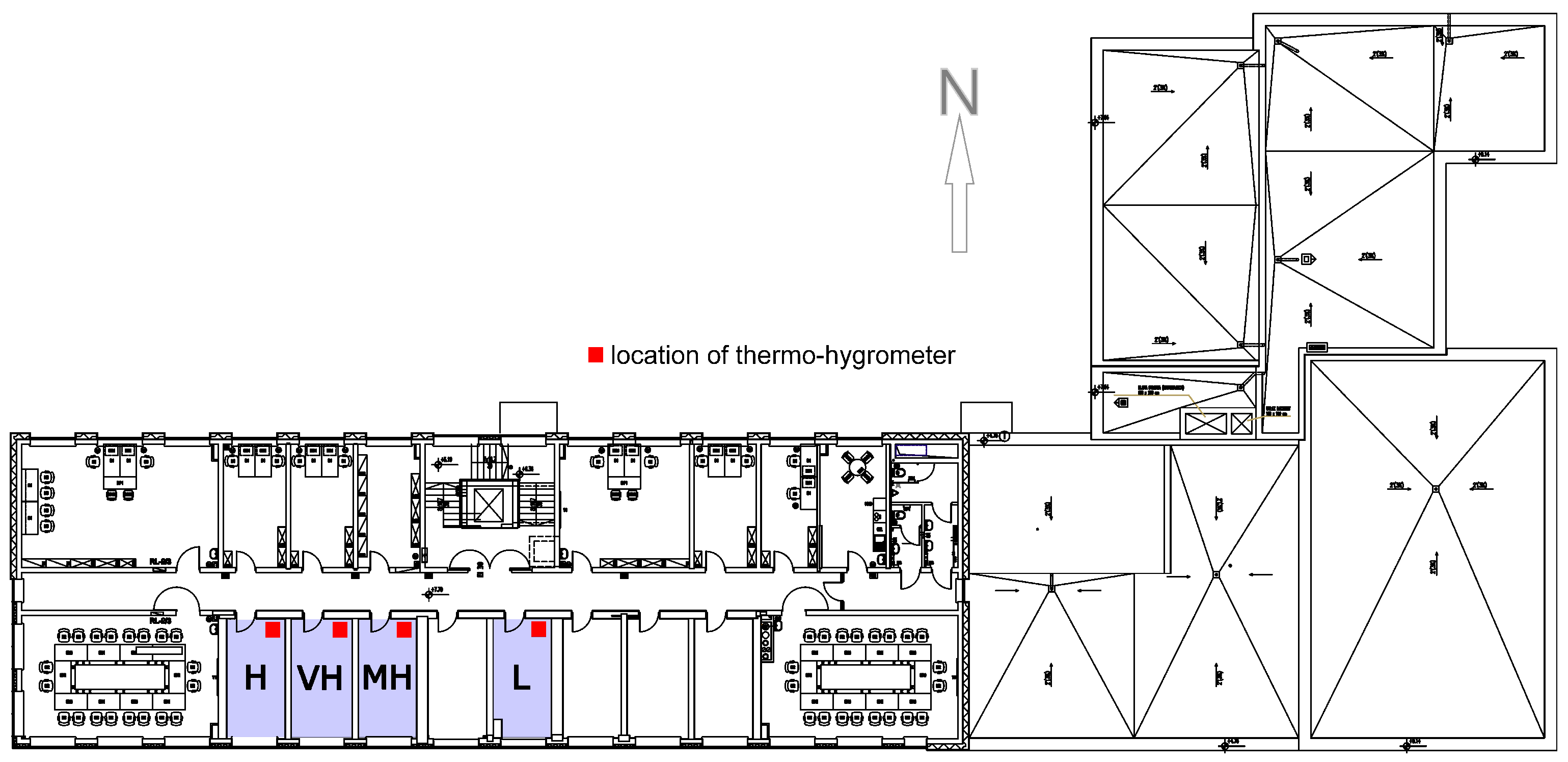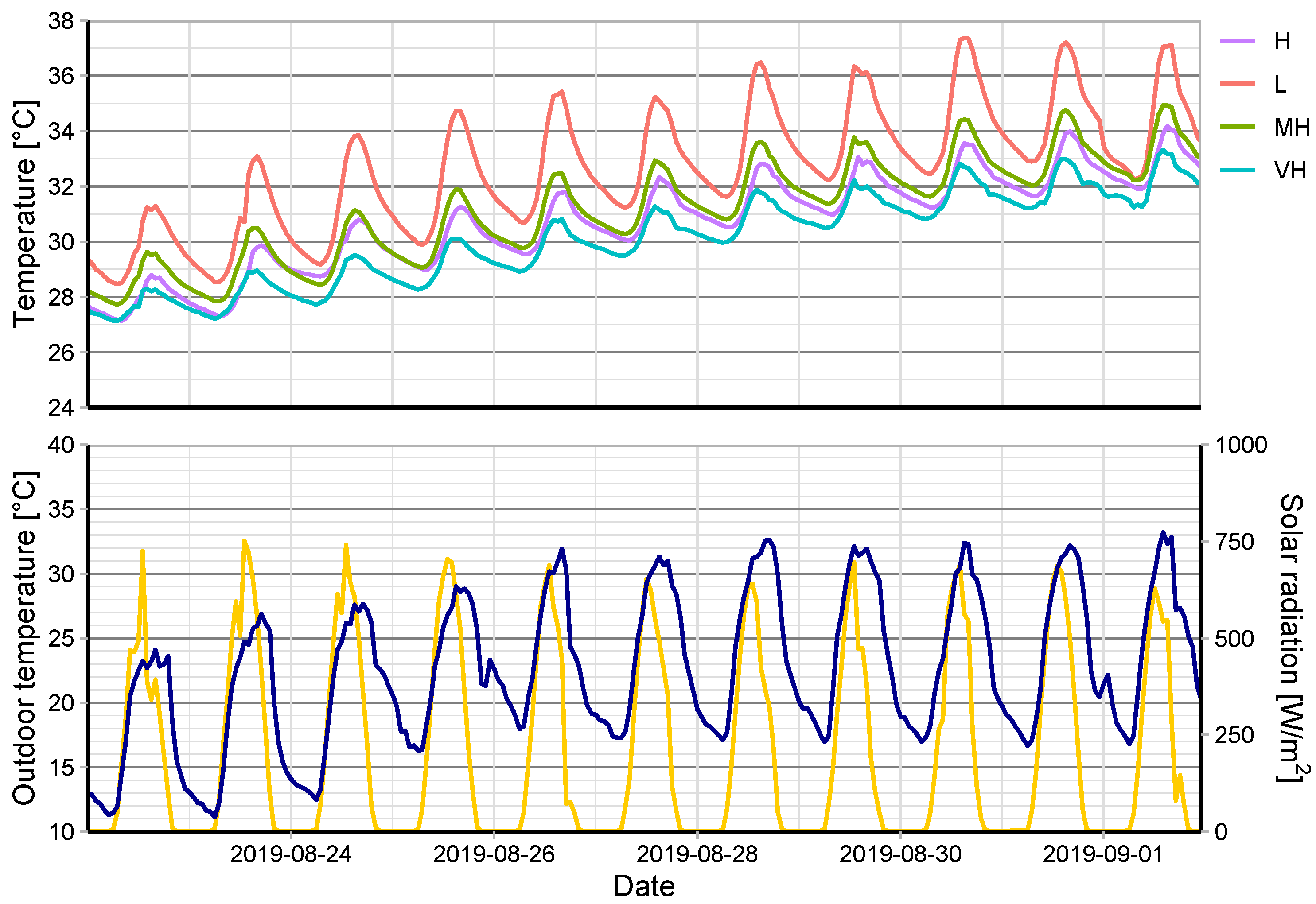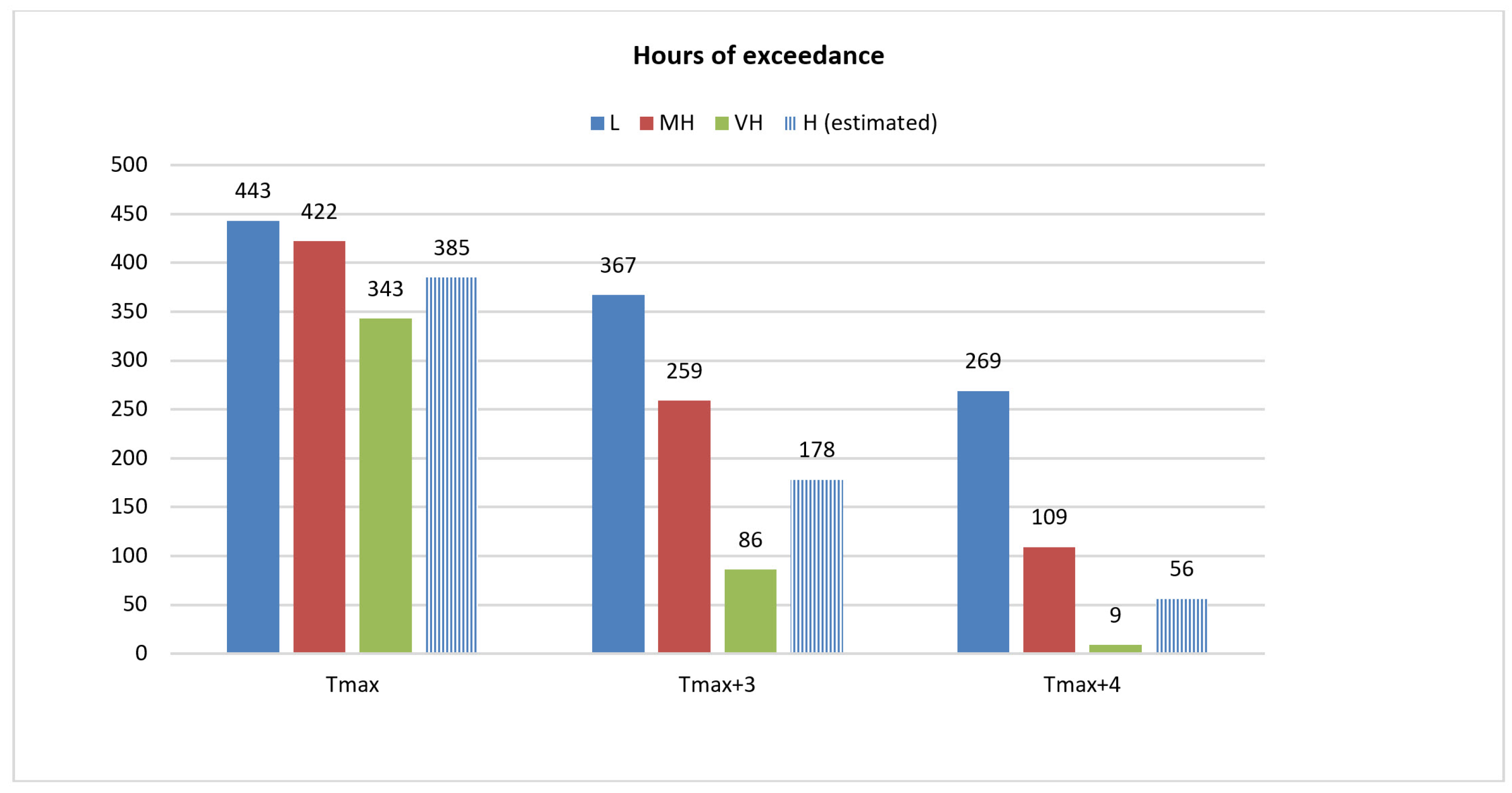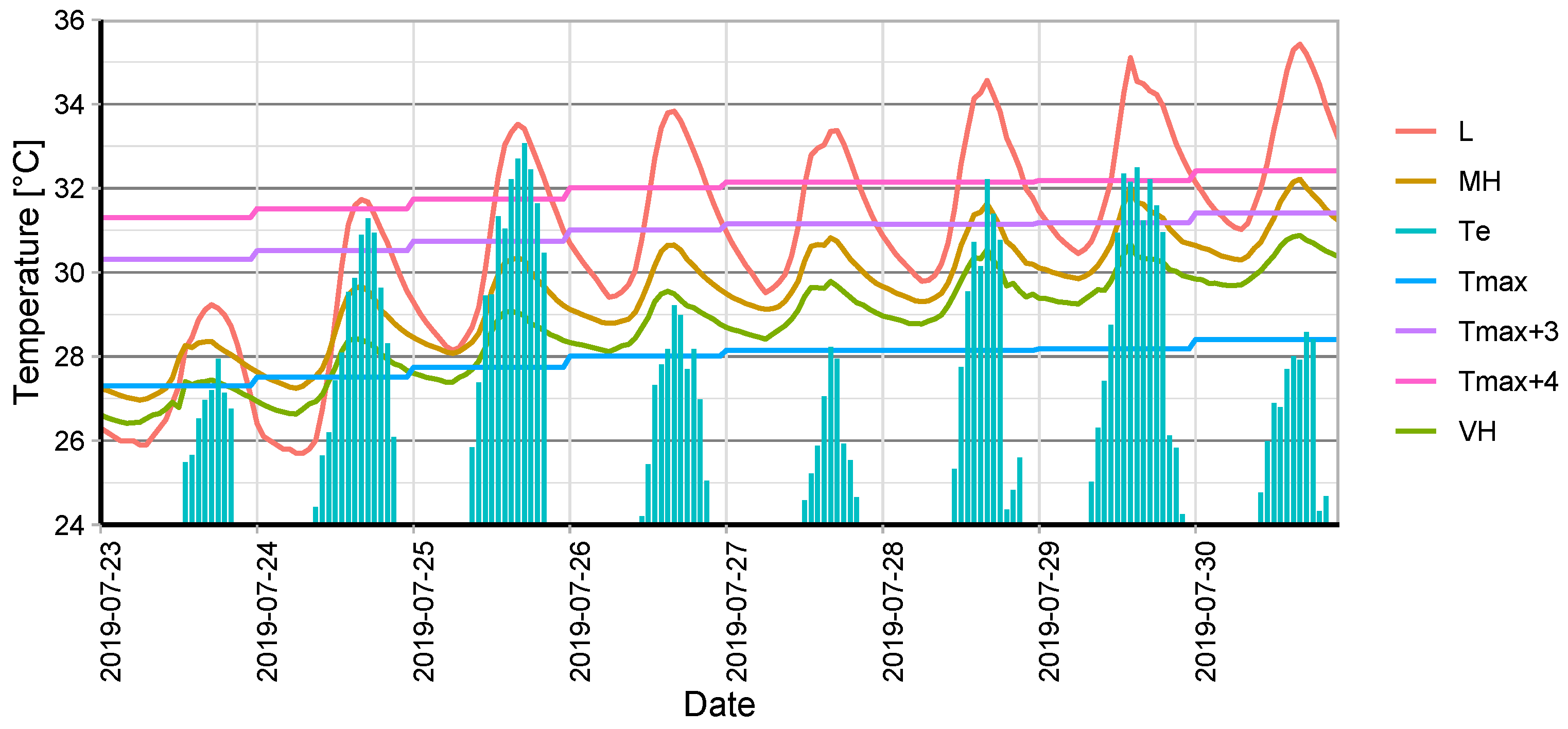The Effect of the Thermal Mass of the Building Envelope on Summer Overheating of Dwellings in a Temperate Climate
Abstract
:1. Introduction
1.1. Effect of Global Warming on Outdoor Temperature in Europe
1.2. Present and Future of Indoor Temperatures in Residential Buildings in a Temperate Climate
1.3. Passive Measures to Prevent Overheating in Residential Buildings
1.4. Passive Measures and User Expectations and Behavior
- Physical environmental: weather, air quality, air temperature and humidity, noise, odors,
- contextual: building archetype, construction, location, window orientation, neighborhood, A/C and ventilation systems and their control, etc.,
- physiological: age, gender, health status, activity level, past thermal experience, clothing, food energy value,
- psychological: attitudes, preferences, values, habits, concerns, expectations concerning thermal comfort, visual comfort, acoustical comfort, health, safety, financial and environmental concerns), cognitive resources (the level of awareness regarding environmental aspects, lifestyle, etc.),
- social: sociocultural norms and practices or cultural background referring to the interaction between occupants, the structure of the decision-making hierarchy related to the control of the internal environment (e.g., the thermostat set point, the opening/closing of windows or blinds).
1.5. Thermal Mass
2. Methodology
2.1. Characteristics of Experimental Rooms
2.2. Materials and Constructions
- Type 1: light residential buildings, rather uncommon in Poland, but growing in popularity in recent years (with walls and ceiling based on a timber frame filled with mineral wool and with plasterboard on the inside—Room L; thermal mass parameter = 152 /()
- Type 2: medium heavy construction (concrete floor with gres tiles, walls—lime sand blocks with gypsum plaster ceiling based on a timber frame filled with mineral wool and with plasterboard on the inside)—Room MH; thermal mass parameter = 474 /()
- Type 3: heavy construction, very common in Polish residential buildings (concrete floor with gres tiles, walls—lime sand blocks with gypsum plaster, reinforced concrete roof with gypsum plaster,)—Room H; thermal mass parameter = 724 /()
- Type 4: very heavy construction, rather uncommon in the residential buildings in Poland which ensure the greatest possible effective thermal mass (concrete floor with gres tiles, reinforced concrete walls and ceiling with no plaster, resulting in a strongly exposed concrete surface)—Room VH; thermal mass parameter = 922 /()
2.3. Measurements
- inside the experimental rooms (air temperature and air humidity),
- outside the building (outdoor parameters: air temperature and global horizontal solar radiation).
- (a)
- 1–30 June (mean outdoor temperature °C; mean maximum outdoor temperature °C),
- (b)
- 23–30 July (mean outdoor temperature °C; mean maximum outdoor temperature °C),
- (c)
- 24 August to 1 September (mean outdoor temperature °C; mean maximum outdoor temperature °C).
3. Results and Discussion
4. Conclusions
Work Limitations and Future Work
Author Contributions
Funding
Informed Consent Statement
Conflicts of Interest
References
- Christidis, N.; McCarthy, M.; Stott, P.A. The increasing likelihood of temperatures above 30 to 40 °C in the United Kingdom. Nat. Commun. 2020, 11, 1–10. [Google Scholar] [CrossRef]
- Jan van Oldenborgh, G.; Philip, S.; Kew, S.; Otto, F.; Haustein, K.; Vautard, R.; Boucher Jean-Michel Soubeyroux, O.; Ribes, A.; Robin Sonia Seneviratne, Y.I.; Vogel, M.M. Human Contribution to the Record-Breaking June 2019 Heat Wave in France; Technical Report; World Weather Attribution: Paris, France, 2019. [Google Scholar]
- McCarthy, M.; Christidis, N.; Dunstone, N.; Fereday, D.; Kay, G.; Klein-Tank, A.; Lowe, J.; Petch, J.; Scaife, A.; Stott, P. Drivers of the UK summer heatwave of 2018. Weather 2019, 74, 390–396. [Google Scholar] [CrossRef]
- Hughes, C.; Natarajan, S. Summer thermal comfort and overheating in the elderly. Build. Serv. Eng. Res. Technol. 2019, 40, 426–445. [Google Scholar] [CrossRef]
- Beizaee, A.; Lomas, K.J.; Firth, S.K. National survey of summertime temperatures and overheating risk in English homes. Build. Environ. 2013, 65, 1–17. [Google Scholar] [CrossRef] [Green Version]
- Wright, A.; Young, A.; Natarajan, S. Dwelling temperatures and comfort during the August 2003 heat wave. Build. Serv. Eng. Res. Technol. 2005, 26, 285–300. [Google Scholar] [CrossRef]
- Tabatabaei Sameni, S.M.; Gaterell, M.; Montazami, A.; Ahmed, A. Overheating investigation in UK social housing flats built to the Passivhaus standard. Build. Environ. 2015, 92, 222–235. [Google Scholar] [CrossRef] [Green Version]
- Hamdy, M.; Carlucci, S.; Hoes, P.J.; Hensen, J.L. The impact of climate change on the overheating risk in dwellings—A Dutch case study. Build. Environ. 2017, 122, 307–323. [Google Scholar] [CrossRef]
- Pathan, A.; Mavrogianni, A.; Summerfield, A.; Oreszczyn, T.; Davies, M. Monitoring summer indoor overheating in the London housing stock. Energy Build. 2017, 141, 361–378. [Google Scholar] [CrossRef]
- Taylor, J.; Mavrogianni, A.; Davies, M.; Das, P.; Shrubsole, C.; Biddulph, P.; Oikonomou, E. Understanding and mitigating overheating and indoor PM 2.5 risks using coupled temperature and indoor air quality models. Build. Serv. Eng. Res. Technol. 2015, 36, 275–289. [Google Scholar] [CrossRef]
- Tian, Z.; Zhang, S.; Deng, J.; Dorota Hrynyszyn, B. Evaluation on Overheating Risk of a Typical Norwegian Residential Building under Future Extreme Weather Conditions. Energies 2020, 13, 658. [Google Scholar] [CrossRef] [Green Version]
- Psomas, T.; Heiselberg, P.; Duer, K.; Bjørn, E. Overheating risk barriers to energy renovations of single family houses: Multicriteria analysis and assessment. Energy Build. 2016, 117, 138–148. [Google Scholar] [CrossRef]
- Abdulla, Z.; Rodrigues, L. The effect of shading, infiltration and ventilation levels on overheating and heating demands in UK residential buildings. Case study: Trent Basin Regeneration. In Proceedings of the 36th International Conference on Passive and Low Energy Architecture, Cities, Buildings, People: Towards Regenerative Environments (PLEA 2016), Los Angeles, CA, USA, 11–13 July 2016. [Google Scholar]
- Adekunle, T.O.; Nikolopoulou, M. Thermal comfort, summertime temperatures and overheating in prefabricated timber housing. Build. Environ. 2016, 103, 21–35. [Google Scholar] [CrossRef]
- Rodrigues, L.; Sougkakis, V.; Gillott, M. Investigating the potential of adding thermal mass to mitigate overheating in a super-insulated low-energy timber house. Int. J. Low-Carbon Technol. 2016, 11, 305–316. [Google Scholar] [CrossRef] [Green Version]
- Stazi, F.; Tomassoni, E.; Di Perna, C. Super-insulated wooden envelopes in Mediterranean climate: Summer overheating, thermal comfort optimization, environmental impact on an Italian case study. Energy Build. 2017, 138, 716–732. [Google Scholar] [CrossRef]
- Gamero-Salinas, J.C.; Monge-Barrio, A.; Sánchez-Ostiz, A. Overheating risk assessment of different dwellings during the hottest season of a warm tropical climate. Build. Environ. 2020, 171, 106664. [Google Scholar] [CrossRef]
- Pomfret, L.; Hashemi, A. Thermal Comfort in Zero Energy Buildings. Energy Procedia 2017, 134, 825–834. [Google Scholar] [CrossRef] [Green Version]
- Kurnitski, J.; Saari, A.; Kalamees, T.; Vuolle, M.; Niemelä, J.; Tark, T. Cost optimal and nearly zero (nZEB) energy performance calculations for residential buildings with REHVA definition for nZEB national implementation. Energy Build. 2011, 43, 3279–3288. [Google Scholar] [CrossRef]
- Niskanen, J.; Rohracher, H. Passive houses as affiliative objects: Investment calculations, energy modelling, and collaboration strategies of Swedish housing companies. Energy Res. Soc. Sci. 2020, 70, 101643. [Google Scholar] [CrossRef]
- Jones, R.V.; Goodhew, S.; De Wilde, P. Measured indoor temperatures, thermal comfort and overheating risk: Post-occupancy evaluation of low energy houses in the UK. Energy Procedia 2016, 88, 714–720. [Google Scholar] [CrossRef] [Green Version]
- Dartevelle, O.; van Moeseke, G.; Mlecnik, E.; Altomonte, S. Long-term evaluation of residential summer thermal comfort: Measured vs. perceived thermal conditions in nZEB houses in Wallonia. Build. Environ. 2021, 190, 107531. [Google Scholar] [CrossRef]
- Puckett, K.; Gethering, W. Design for Climate Change; Riba Publishing: London, UK, 2013; p. 196. [Google Scholar]
- Peacock, A.D.; Jenkins, D.P.; Kane, D. Investigating the potential of overheating in UK dwellings as a consequence of extant climate change. Energy Policy 2010, 38, 3277–3288. [Google Scholar] [CrossRef]
- Jakubcionis, M.; Carlsson, J. Estimation of European Union residential sector space cooling potential. Energy Policy 2017, 101, 225–235. [Google Scholar] [CrossRef]
- Andreou, A.; Barrett, J.; Taylor, P.G.; Brockway, P.E.; Wadud, Z. Decomposing the drivers of residential space cooling energy consumption in EU-28 countries using a panel data approach. Energy Built Environ. 2020, 1, 432–442. [Google Scholar] [CrossRef]
- Birchmore, R.; Davies, K.; Etherington, P.; Tait, R.; Pivac, A. Overheating in Auckland homes: Testing and interventions in full-scale and simulated houses. Build. Res. Inf. 2017, 45, 157–175. [Google Scholar] [CrossRef]
- Amaral, A.R.; Rodrigues, E.; Gaspar, A.R.; Gomes, Á. A thermal performance parametric study of window type, orientation, size and shadowing effect. Sustain. Cities Soc. 2016, 26, 456–465. [Google Scholar] [CrossRef] [Green Version]
- Rodrigues, L.T.; Gillott, M.; Tetlow, D. Summer overheating potential in a low-energy steel frame house in future climate scenarios. Sustain. Cities Soc. 2013, 7, 1–15. [Google Scholar] [CrossRef]
- Zukowska, D.; Ananida, M.; Kolarik, J.; Sarey Khanie, M.; Rammer Nielsen, T. Solar control solutions for reducing overheating risks in retrofitted Danish apartment buildings from the period 1850–1900—A simulation-based study. E3S Web Conf. 2019, 111. [Google Scholar] [CrossRef] [Green Version]
- Grussa, Z.D.; Andrews, D.; Lowry, G.; Newton, E.J.; Yiakoumetti, K.; Chalk, A.; Bush, D. A London residential retrofit case study: Evaluating passive mitigation methods of reducing risk to overheating through the use of solar shading combined with night-time ventilation. Build. Serv. Eng. Res. Technol. 2019, 40, 389–408. [Google Scholar] [CrossRef]
- Ibrahim, A.; Pelsmakers, S.L. Low-energy housing retrofit in North England: Overheating risks and possible mitigation strategies. Build. Serv. Eng. Res. Technol. 2018, 39, 161–172. [Google Scholar] [CrossRef] [Green Version]
- Mavrogianni, A.; Davies, M.; Taylor, J.; Chalabi, Z.; Biddulph, P.; Oikonomou, E.; Das, P.; Jones, B. The impact of occupancy patterns, occupant-controlled ventilation and shading on indoor overheating risk in domestic environments. Build. Environ. 2014, 78, 183–198. [Google Scholar] [CrossRef]
- Lee, W.V.; Shaman, J. Heat-coping strategies and bedroom thermal satisfaction in New York City. Sci. Total. Environ. 2017, 574, 1217–1231. [Google Scholar] [CrossRef] [Green Version]
- Kalema, T.; Jóhannesson, G.; Pylsy, P.; Hagengran, P. Accuracy of Energy Analysis of Buildings: A Comparison of a Monthly Energy Balance Method and Simulation Methods in Calculating the Energy Consumption and the Effect of Thermal Mass. J. Build. Phys. 2008, 32, 101–130. [Google Scholar] [CrossRef]
- Brambilla, A.; Jusselme, T. Preventing overheating in offices through thermal inertial properties of compressed earth bricks: A study on a real scale prototype. Energy Build. 2017, 156, 281–292. [Google Scholar] [CrossRef]
- Kuczyński, T.; Staszczuk, A. Experimental study of the influence of thermal mass on thermal comfort and cooling energy demand in residential buildings. Energy 2020, 195, 116984. [Google Scholar] [CrossRef]
- Gagliano, A.; Nocera, F.; Patania, F.; Moschella, A.; Detommaso, M.; Evola, G. Synergic effects of thermal mass and natural ventilation on the thermal behaviour of traditional massive buildings. Int. J. Sustain. Energy 2016, 35, 411–428. [Google Scholar] [CrossRef]
- Roucoult, J.M.; Douzane, O.; Langlet, T. Incorporation of thermal inertia in the aim of installing a natural nighttime ventilation system in buildings. Energy Build. 1999, 29, 129–133. [Google Scholar] [CrossRef]
- Brambilla, A.; Bonvin, J.; Flourentzou, F.; Jusselme, T. On the Influence of Thermal Mass and Natural Ventilation on Overheating Risk in Offices. Buildings 2018, 8, 47. [Google Scholar] [CrossRef] [Green Version]
- Fabi, V.; Andersen, R.V.; Corgnati, S.; Olesen, B.W. Occupants’ window opening behaviour: A literature review of factors influencing occupant behaviour and models. Build. Environ. 2012, 58, 188–198. [Google Scholar] [CrossRef]
- Van Den Wymelenberg, K. Patterns of occupant interaction with window blinds: A literature review. Energy Build. 2012, 51, 165–176. [Google Scholar] [CrossRef]
- Schweiker, M. Occupant Behaviour and the Related Reference Levels for Heating and Cooling. Ph.D. Thesis, Tokyo City University, Tokyo, Japan, 2010. [Google Scholar]
- Ajzen, I.; Brown, T.C.; Carvajal, F. Explaining the discrepancy between intentions and actions: The case of hypothetical bias in contingent valuation. Personal. Soc. Psychol. Bull. 2004, 30, 1108–1121. [Google Scholar] [CrossRef] [PubMed]
- Ajzen, I.; Fishbein, M. The influence of attitudes on behaviour. In The Handbook of Attitudes; Albarracìn, D., Johnson, B., Zanna, M., Eds.; Erlbaum: Washington, DC, USA, 2005; pp. 173–221. [Google Scholar]
- Refsgaard, K.; Magnussen, K. Household behaviour and attitudes with respect to recycling food waste–experiences from focus groups. J. Environ. Manag. 2009, 90, 760–771. [Google Scholar] [CrossRef] [PubMed]
- Seligman, C.; Kriss, M.; Darley, J.M.; Fazio, R.H.; Becker, L.J.; Pryor, J.B. Predicting Summer Energy Consumption from Homeowners’ Attitudes1. J. Appl. Soc. Psychol. 1979, 9, 70–90. [Google Scholar] [CrossRef]
- Bekö, G.; Toftum, J.; Clausen, G. Modeling ventilation rates in bedrooms based on building characteristics and occupant behavior. Build. Environ. 2011, 46, 2230–2237. [Google Scholar] [CrossRef]
- Lomas, K.J.; Porritt, S.M. Overheating in buildings: Lessons from research. Build. Res. Inf. 2017, 45, 1–18. [Google Scholar] [CrossRef] [Green Version]
- Zuurbier, M.; van Loenhout, J.A.F.; le Grand, A.; Greven, F.; Duijm, F.; Hoek, G. Street temperature and building characteristics as determinants of indoor heat exposure. Sci. Total. Environ. 2021, 766, 144376. [Google Scholar] [CrossRef]
- Börjesson, P.; Gustavsson, L. Greenhouse gas balances in building construction: Wood versus concrete from life-cycle and forest land-use perspectives. Energy Policy 2000, 28, 575–588. [Google Scholar] [CrossRef]
- Gustavsson, L.; Pingoud, K.; Sathre, R. Carbon dioxide balance of wood substitution: Comparing concrete- and wood-framed buildings. Mitig. Adapt. Strateg. Glob. Chang. 2006, 11, 667–691. [Google Scholar] [CrossRef]
- Lenzen, M.; Treloar, G. Embodied energy in buildings: Wood versus concrete—Reply to Börjesson and Gustavsson. Energy Policy 2002, 30, 249–255. [Google Scholar] [CrossRef]
- Gerilla, G.P.; Teknomo, K.; Hokao, K. An environmental assessment of wood and steel reinforced concrete housing construction. Build. Environ. 2007, 42, 2778–2784. [Google Scholar] [CrossRef]
- De Gracia, A.; Rincón, L.; Castell, A.; Jiménez, M.; Boer, D.; Medrano, M.; Cabeza, L.F. Life Cycle Assessment of the inclusion of phase change materials (PCM) in experimental buildings. Energy Build. 2010, 42, 1517–1523. [Google Scholar] [CrossRef]
- Menoufi, K.; Castell, A.; Navarro, L.; Pérez, G.; Boer, D.; Cabeza, L.F. Evaluation of the environmental impact of experimental cubicles using Life Cycle Assessment: A highlight on the manufacturing phase. Appl. Energy 2012, 92, 534–544. [Google Scholar] [CrossRef]
- Castell, A.; Menoufi, K.; de Gracia, A.; Rincón, L.; Boer, D.; Cabeza, L.F. Life Cycle Assessment of alveolar brick construction system incorporating phase change materials (PCMs). Appl. Energy 2013, 101, 600–608. [Google Scholar] [CrossRef]
- Sage-Lauck, J.S.; Sailor, D.J. Evaluation of phase change materials for improving thermal comfort in a super-insulated residential building. Energy Build. 2014, 79, 32–40. [Google Scholar] [CrossRef]
- Alam, M.; Zou, P.X.; Sanjayan, J.; Ramakrishnan, S. Energy saving performance assessment and lessons learned from the operation of an active phase change materials system in a multi-storey building in Melbourne. Appl. Energy 2019, 238, 1582–1595. [Google Scholar] [CrossRef]
- Sinka, M.; Bajare, D.; Jakovics, A.; Ratnieks, J.; Gendelis, S.; Tihana, J. Experimental testing of phase change materials in a warm-summer humid continental climate. Energy Build. 2019, 195, 205–215. [Google Scholar] [CrossRef]
- Khudhair, A.M.; Farid, M.M. Use of phase change materials for thermal comfort and electrical energy peak load shifting: Experimental investigations. In Proceedings of ISES World Congress 2007; Springer: Berlin/Heidelberg, Germany, 2007; Volume 1, pp. 283–288. [Google Scholar] [CrossRef]
- Reilly, A.; Kinnane, O. The impact of thermal mass on building energy consumption. Appl. Energy 2017, 198, 108–121. [Google Scholar] [CrossRef] [Green Version]
- GUS. Budownictwo w 2018 r.; Technical Report; GUS: Warszawa, Poland, 2019. [Google Scholar]
- Staszczuk, A.; Kuczyński, T. The impact of wall and roof material on the summer thermal performance of building in a temperate climate. Energy 2021, 228, 120482. [Google Scholar] [CrossRef]
- Bellamy, L.A.; Mackenzie, D.W. Thermal Performance of Buildings with Heavy Walls; BRANZ: Judgeford, New Zealand, 2002. [Google Scholar]
- Tink, V.; Porritt, S.; Allinson, D.; Loveday, D. Measuring and mitigating overheating risk in solid wall dwellings retrofitted with internal wall insulation. Build. Environ. 2018, 141, 247–261. [Google Scholar] [CrossRef]
- Jakovičs, A.; Gendelis, S.; Bandeniece, L. Energy efficiency and sustainability of different building structures in Latvian climate. In IOP Conference Series: Materials Science and Engineering; Institute of Physics Publishing: Riga, Latvia, 2015; Volume 96. [Google Scholar] [CrossRef]
- Grynning, S.; Nocente, A.; Gullbrekken, L.; Skjeggerud, K. Thermal mass and thermal comfort in offices—Experimental studies of a concrete floor. MATEC Web Conf. 2019, 282, 02087. [Google Scholar] [CrossRef]
- Vik, T.A.; Madessa, H.B.; Aslaksrud, P.; Folkedal, E.; Øvrevik, O.S. Thermal Performance of an Office Cubicle Integrated with a Bio-based PCM: Experimental Analyses. Energy Procedia 2017, 111, 609–618. [Google Scholar] [CrossRef]
- Ramakrishnan, S.; Wang, X.; Sanjayan, J.; Wilson, J. Thermal performance assessment of phase change material integrated cementitious composites in buildings: Experimental and numerical approach. Appl. Energy 2017, 207, 654–664. [Google Scholar] [CrossRef]
- Schossig, P.; Henning, H.M.; Gschwander, S.; Haussmann, T. Micro-encapsulated phase-change materials integrated into construction materials. Sol. Energy Mater. Sol. Cells 2005, 89, 297–306. [Google Scholar] [CrossRef]
- Voelker, C.; Kornadt, O.; Ostry, M. Temperature reduction due to the application of phase change materials. Energy Build. 2008, 40, 937–944. [Google Scholar] [CrossRef] [Green Version]










| Assembly | U [W/(m2K)] | A [m2] |
|---|---|---|
| External wall Room H | 5 | |
| External wall Room VH | 5 | |
| External wall Room MH | 5 | |
| External wall Room L | 5 | |
| Internal wall Seminar Room/H | 19 | |
| Internal wall Room H/VH | 19 | |
| Internal wall Room VH/MH | 19 | |
| Internal wall surrounding room/L | 19 | |
| Internal wall Room L/surrounding room | 19 | |
| Internal wall Hall/Room H | 8 | |
| Internal wall Hall/Room VH | 8 | |
| Internal wall Hall/Room MH | 8 | |
| Internal wall Hall/Room L | 8 | |
| Floor Room H, VH, MH | 18 | |
| Floor Room L | 18 | |
| Roof Room H | 18 | |
| Roof Room VH | 18 | |
| Roof Room MH, L | 18 | |
| Windows triple glazing, SHGC (av.) = | ||
| Uw-mounted = /(); Ug = /() |
| Material | [W/(mK)] | [kg/m] | c [J/(kg K)] |
|---|---|---|---|
| Air layer | 1000 | ||
| Aerated concrete blocks | 400 | 840 | |
| Ceramic brick | 1900 | 880 | |
| Concrete screed layer | 1800 | 1000 | |
| EPS | 20 | 1460 | |
| Floor carpeting | 200 | 1300 | |
| Gypsum board | 900 | 1000 | |
| Gypsum plaster | 1000 | 1000 | |
| Gres tiles | 2000 | 920 | |
| Lime sand blocks | 1600 | 1000 | |
| Mineral wool | 90 | 1030 | |
| OSB | 650 | 1700 | |
| PE-Membrane | 920 | 2200 | |
| Bucket foil | 980 | 1800 | |
| Reinforced concrete | 2500 | 840 | |
| Roof covering (asphalt) | 1000 | 1460 | |
| Textured plaster | 1850 | 840 | |
| Trapez metal sheet | 2500 | 840 |
| Authors | Place of Research | Type of Climate | Type of Research | Structural Elements | ΔTmax | Ref. |
|---|---|---|---|---|---|---|
| This research | Zielona Góra, Poland | (Cfb-climate) | Experimental | Walls & roof | 2.2–2.6 K (M v. L) 3.6–4.3 K (VH v. L) 2.8–3.5 K (H v. L) | |
| Kuczyński & Staszczuk, 2020 | Zielona Góra, Poland | Cfb-climate | Experimental | Walls | 1.5–2.5 K | [37] |
| Staszczuk & Kuczyński, 2021 | Zielona Góra, Poland | Cfb-climate | Experimental | Walls & roof * | 1.5–2.5 K | [64] |
| Bellamy & Mckenzie, 2001 | Lincoln, New Zealand | Cfb-climate | Experimental | Walls | 3.0–5.0 K | [65] |
| Tink et al., 2018 | Leicestershire, UK | Cfb-climate | Experimental | Walls | 2.5 K | [66] |
| Jakovics et al., 2015 | Riga, Latvia | Cfb-climate | Experimental | Walls | 3.0–4.0 K | [67] |
| Grynning et al., 2019 | Trondheim, Norway | Dfb-climate | Experimental | Floor | 2.5–3.0 K | [68] |
| Brambilla & Jusselme, 2017 | Fribourg, Switzerland | Cfb-climate | Experimental | Walls | 1.1–3.0 K | [36] |
| Sage-Lauck & Sailor, 2014 | Portland, USA | Cfb-climate | Experimental (PCM) | Walls & roof | 1.1 K | [58] |
| Jamil et al., 2016 | Melbourne, Australia | Cfb-climate | Experimental (PCM) | Roof | 1.1 K | |
| Khudhair & Farid, 2007 | Auckland, New Zealand | Cfb-climate | Experimental (PCM) | Walls & roof | 2.4 K | [61] |
| Vik et al., 2017 | Oslo | Dfb-climate | Experimental (PCM) | 1 walls & roof | 3.3 K ** 2.6 K *** | [69] |
| Ramaskrishnan et al., 2017 | Melbourne, Australia | Cfb-climate | Experimental (PCM) | Walls & roof | 2.5–2.8 K | [70] |
| Schossig et al., 2016 | Freiburg, Germany | Cfb-climate | Experimental (PCM) | Walls & roof | 1.0–3.5 K | [71] |
| Voelker et al., 2007 | Weimar, Germany | Cfb-climate | Experimental (PCM) | Walls & roof | 0.5–4.0 K | [72] |
Publisher’s Note: MDPI stays neutral with regard to jurisdictional claims in published maps and institutional affiliations. |
© 2021 by the authors. Licensee MDPI, Basel, Switzerland. This article is an open access article distributed under the terms and conditions of the Creative Commons Attribution (CC BY) license (https://creativecommons.org/licenses/by/4.0/).
Share and Cite
Kuczyński, T.; Staszczuk, A.; Ziembicki, P.; Paluszak, A. The Effect of the Thermal Mass of the Building Envelope on Summer Overheating of Dwellings in a Temperate Climate. Energies 2021, 14, 4117. https://doi.org/10.3390/en14144117
Kuczyński T, Staszczuk A, Ziembicki P, Paluszak A. The Effect of the Thermal Mass of the Building Envelope on Summer Overheating of Dwellings in a Temperate Climate. Energies. 2021; 14(14):4117. https://doi.org/10.3390/en14144117
Chicago/Turabian StyleKuczyński, Tadeusz, Anna Staszczuk, Piotr Ziembicki, and Anna Paluszak. 2021. "The Effect of the Thermal Mass of the Building Envelope on Summer Overheating of Dwellings in a Temperate Climate" Energies 14, no. 14: 4117. https://doi.org/10.3390/en14144117
APA StyleKuczyński, T., Staszczuk, A., Ziembicki, P., & Paluszak, A. (2021). The Effect of the Thermal Mass of the Building Envelope on Summer Overheating of Dwellings in a Temperate Climate. Energies, 14(14), 4117. https://doi.org/10.3390/en14144117






